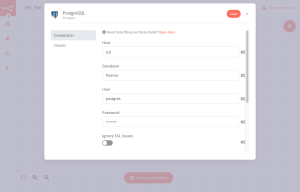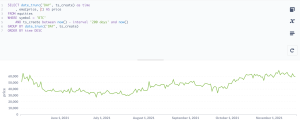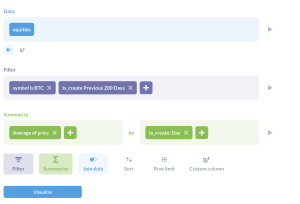Executive Overview
This document aims to tour a selection of open source software leveraged for market analysis. The default system samples public cryptocurrency data.
https://github.com/mashiox/analytics-engine
Requirements
- Docker https://docs.docker.com/desktop/
- Docker compose https://docs.docker.com/compose/
- PostgreSQL https://www.postgresql.org/docs/13/
- n8n https://n8n.io/
- Metabase https://www.metabase.com/
- Git
Basic understanding of these technologies and their fundamental concepts is assumed in the writing of this document.
There are three core requirements for this system. Data storage provided by PostgreSQL, automation by n8n, and dashboard rendering by Metabase.
These services may be deployed on bare-metal servers, virtual machines, and containers. Descriptions of different deployment and installation methods are out of scope for this document. The minimal docker-compose definition, referred to below, comes with several caveats. It is not intended as a production-ready system.
The GitHub repository includes the full docker-compose.yml definition and the minimal version. Q&A support is offered in the repository’s GitHub Issues
#
# Minimal Analytics Engine
# Author: Matthew Walther <code@mashio.net>
#
version: "3.7"
services:
sql:
container_name: sql
image: postgres:13
volumes:
- ./sql/initdb.d/:/docker-entrypoint-initdb.d/
environment:
- POSTGRES_DB=postgres
- POSTGRES_USER=postgres
- POSTGRES_PASSWORD=postgres
metabase:
container_name: metabase
image: metabase/metabase:latest
ports:
- "127.0.0.1:3000:3000"
environment:
- MB_JETTY_PORT=3000
- MB_DB_TYPE=postgres
- MB_DB_HOST=sql
- MB_DB_DBNAME=metabase
- MB_DB_USER=postgres
- MB_DB_PASS=postgres
- MB_DB_PORT=5432
- MB_EMOJI_IN_LOGS=false
depends_on:
- sql
n8n:
container_name: n8n
image: n8nio/n8n:latest
ports:
- "127.0.0.1:5678:5678"
volumes:
- ./n8n:/home/node/.n8n
environment:
- DB_TYPE=postgresdb
- DB_POSTGRESDB_HOST=sql
- DB_POSTGRESDB_DATABASE=n8n
- DB_POSTGRESDB_USER=postgres
- DB_POSTGRESDB_PASSWORD=postgres
depends_on:
- sqlActivating Services
Steps
These steps will clone the required code and docker files to start the analytics engine.
PostgreSQL will start before the other services. It will migrate the SQL definitions located in the sql/ directory of the repository. These files define database, table, and function definitions that the environment's services and features require.
After the sql container finishes the first-time run procedure it will begin waiting for connections. At this point, n8n and metabase will begin migrating their schemas to the database.
git clone https://github.com/mashiox/analytics-engine.git /opt/mashiox/analytics-engine
cd /opt/mashiox/analytics-engine
docker-compose pull
docker-compose up -dPostgreSQL
PostgreSQL is a powerful database engine. The chief goal is to use it to store market data, and perform advanced calculations when the Metabase analytics engine can not help us.
Health Check
Here is how to ensure PostgreSQL has all the necessary definitions for the environment of services.
docker-compose exec sql su - postgres
psqlCheck that the tables: n8n, metabase, and finance exist and are owned by the postgres user defined in the docker-compose.yml file.
postgres=# \l
List of databases
Name | Owner | Encoding | Collate | Ctype | Access privileges
-----------+----------+----------+------------+------------+-----------------------
finance | postgres | UTF8 | en_US.utf8 | en_US.utf8 |
metabase | postgres | UTF8 | en_US.utf8 | en_US.utf8 |
n8n | postgres | UTF8 | en_US.utf8 | en_US.utf8 |
postgres | postgres | UTF8 | en_US.utf8 | en_US.utf8 |
template0 | postgres | UTF8 | en_US.utf8 | en_US.utf8 | =c/postgres +
| | | | | postgres=CTc/postgres
template1 | postgres | UTF8 | en_US.utf8 | en_US.utf8 | =c/postgres +
| | | | | postgres=CTc/postgres
(6 rows)
Note: The metabase service takes the longest time to migrate. The logs will output INFO db.data-migrations :: Finished running data migrations. when it finishes.
\c metabase
postgres=# \c metabase
You are now connected to database "metabase" as user "postgres".
metabase=# \dt
List of relations
Schema | Name | Type | Owner
--------+--------------------------------------+-------+---------
public | activity | table | postgres
public | card_label | table | postgres
public | collection | table | postgres
public | collection_permission_graph_revision | table | postgres
public | computation_job | table | postgres
...
<cutoff for brevity>
metabase=# \c n8n
You are now connected to database "n8n" as user "postgres".
n8n=# \dt
List of relations
Schema | Name | Type | Owner
--------+--------------------+-------+----------
public | credentials_entity | table | postgres
public | execution_entity | table | postgres
public | migrations | table | postgres
public | tag_entity | table | postgres
public | webhook_entity | table | postgres
public | workflow_entity | table | postgres
public | workflows_tags | table | postgres
(7 rows)
\c finance
finance=# \dt
List of relations
Schema | Name | Type | Owner
--------+----------+-------+----------
public | equities | table | postgres
(1 row)
finance=# \d+ equities
Table "public.equities"
Column | Type | Collation | Nullable | Default | Storage | Stats target | Description
-----------+--------------------------+-----------+----------+-------------------+----------+--------------+-------------
id | uuid | | not null | gen_random_uuid() | plain | |
symbol | character varying(36) | | not null | | extended | |
ts_create | timestamp with time zone | | not null | now() | plain | |
price | numeric(16,4) | | | | main | |
meta | jsonb | | | | extended | |
Indexes:
"equities_pkey" PRIMARY KEY, btree (id)
Access method: heapn8n
https://docs.n8n.io/
https://docs.n8n.io/credentials/postgres/#using-database-connection
https://docs.n8n.io/getting-started/key-components/editor-ui.html#workflows
n8n is an enterprise-grade automation platform, capable of handling a broad range of tasks. Our goal is to use it to poll a web resource for live market data, and persist the results to PostgreSQL.
The first step is to configure the service for use. The docker-compose file gave the n8n system the credentials needed to store system data in the n8n database. n8n’s web interface also requires its own database connection configuration to the finance database.
The default docker-compose configuration provided in the minimal configuration makes http://127.0.0.1:5678 available to connections on the docker host.
Add a new Credential to n8n for the finance Postgres database. And example using the default minimal configuration is given in Figure n8n00.

Figure: Creating the postgresql credential in n8n.
Now we can build a n8n workflow to poll Coincap.io for their listed BTC price, and save it to the database. In n8n, click “Upload a file” under the Workflow menu. Upload the BTC_Poll.json file found in the n8n directory of the repository.
Click the “Postgres” tile on the workflow board. Change the “Credential for Postgres” option to the new Credentials to connect to the finance database.
Clicking “Execute Workflow” will demonstrate a successful execution in n8n. You may check the results of the insert in the database. Name the workflow, and this enables the workflow status. This workflow marked active will poll and save the market BTC price every 5 minutes.
Note: This is not the only way to get data into the database. This workflow only polls the live environment for new data. More work is needed to organize and insert historic data for the equities and their value.
Metabase
https://www.metabase.com/docs/latest/
https://www.metabase.com/docs/latest/users-guide/04-asking-questions.html
https://www.metabase.com/docs/latest/users-guide/custom-questions.html
https://www.metabase.com/docs/latest/users-guide/07-dashboards.html
Metabase is an analytics tool that features a user-friendly UI for analytics and report building. Our goal is to use its native functions to build simple reports on market data.
The default docker-compose definition makes metabase available at http://127.0.0.1:3000. On the initial run, Metabase will guide the user through the onboarding process. Step 3, “Add your data” gives the user the opportunity to connect to the finance database. This step is like the one encountered on n8n to add Credentials.
Metabase makes graphs based on a concept called “Questions.” Questions are Metabase’s way of abstracting database queries. Often, Metabase’s “Custom Question” feature is enough to guide the user through the process of filtering data and rendering it into a graph.
Additionally, Questions may be native SQL queries. Native SQL queries may take advantage of PostgreSQL's advanced tools.
Metabase features Dashboards, which will render several results from saved Questions. Dashboards have a broad range of visualization customization. Dashboards can render more advanced artifacts of question, like linear regressions, and overlaid graphs.

Figure: BTC price from May 2021 through November 2021 against the 200-day exponential moving average
Custom Analysis
https://www.postgresql.org/docs/13/tutorial-views.html
https://www.postgresql.org/docs/13/functions-aggregate.html
PostgreSQL Functions provide a method to perform calculations on a data source. In a way, this is like what Metabase is doing in Figure Metabase02. Postgres not only provides more advanced functions, but gives users flexible languages options.
A common method for sampling the average price of an equity is the Exponential Moving Average (EMA) function. The EMA function is similar to the result of a regression function in the sense that it is a curve-fitting algorithm. Our goal will be to build a graph that visualizes the prior 200-day’s BTC price, and an EMA fit of the underlying BTC result.
To do this, Steve Haslam’s implementation of the EMA function written in PL/pgSQL is included in sql/02-finance.sql. This function is loaded into the finance database, and can be called from Metabase using the “Native Query” Question feature.

Picture: Metabase query builder demonstrating how to build the prior 200-day EMA report.
SELECT date_trunc('DAY', ts_create) as time
, ema(price, 2) AS price
FROM equities
WHERE symbol = 'BTC'
AND ts_create between now() - interval '200 days' and now()
GROUP BY date_trunc('DAY', ts_create)
ORDER BY time DESCNote the parameters used in this particular aggregation are: α=2, Days=200
Create a new Dashboard and add the 200-day BTC price question found in Figure Metabase01. Resize according to personal taste. Click the “Add Series” button found when mousing over the chart on the Dashboard. Find and add the 200-day EMA aggregation, and click done.
Closing Thoughts
We have demonstrated a system which polls live BTC data, and analyzes the results. It is flexible enough to poll and analyze any market equity. Indeed, this system is capable of tackling many numerical analysis problems.
PostgreSQL and n8n carry two features that may make this system desirable to a broad range of users. Users may define Postgres functions in the user’s language of choice. Depending on the nature of the numeric problem, using the right tools may make the implementation better or worse for a lot of reasons.
n8n allows users to run arbitrary commands on the system. This makes n8n carry clear risks for the host system. Those risks may be mitigated by dialing in the system and application environments to isolate the range of damage it may do.
A benefit of this feature is that it may execute application scripts. This enables the user to configure n8n to perform any task that any other component in this system is not suited for. These applications may be built in any environment the user desires, and that can be executed in a POSIX environment.
It should also be said that this environment is minimal, and may not be enough tools for an analyst or data scientist to meet all their goals. There are several other open source tools that may help produce data insights:
- A spreadsheet engine, i.e. LibreOffice Calc
- Jupyter Notebook
- GNU Octave
Looking ahead, there is more to this environment than meets the eye. n8n is a deceivingly powerful tool. Leveraged correctly it can deliver qualitative analytics on top of the quantitative analytics discussed in this document. A system constructed as such could deliver insights previously inaccessible to most public audiences.
